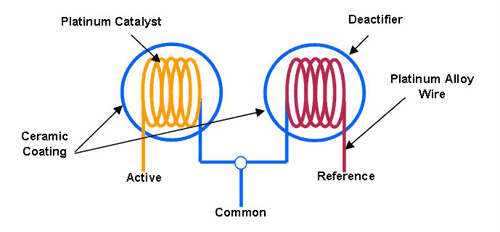Introduction to Arson and Fuel Vapor Detectors
Arson investigators face the challenge of determining the cause of a fire, sometimes with no more than charred remains of a structure to give them the evidence they need. One of the tools often used for gathering evidence is the fuel vapor detector, which can detect trace amounts of propellant in parts per million (ppm) concentrations. Even though the fire has seemingly consumed everything, the fuel vapor detector can "see" evidence which is invisible to the eye.
How Does a Fuel Vapor Detector Work?
The Combustible Sensor consists of two coils of fine platinum wire each embedded in a bead of alumina, connected electrically in a bridge circuit. One of the beads is impregnated with a special catalyst which promotes oxidation and the other is treated to inhibit oxidation. Current is passed through the coils so that they reach a temperature at which oxidation of a gas readily occurs at the catalyzed bead (about 500°C). This raises the temperature further which increases the resistance of the platinum coil in the catalyzed bead, leading to an imbalance of the bridge. This output change is linear, for most gases, up to and beyond 100% LEL and response time is only a few seconds to detect alarm levels (typically 20% LEL). Most fuel vapor monitors can detect concentrations as low as 10 or 20 ppm all the way up to 100%LEL and are typically calibrated with a Hexane gas standard.
Combustible Sensor

